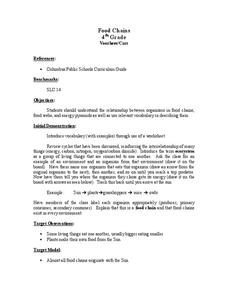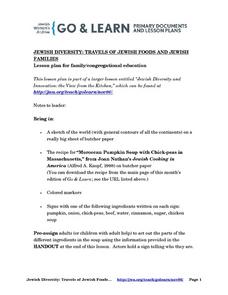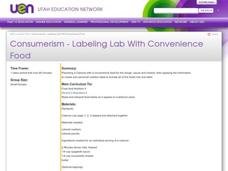Science Matters
Peanut Energy
How do humans get energy since they aren't mechanical and can't photosynthesize? Learners explore this question by relating potential energy in food to human energy levels. Scholars measure the change in mass and a change in temperature...
Nuffield Foundation
Measuring the Vitamin C Content of Foods and Fruit Juices
Are you getting enough vitamin C? Young scientists determine the amount of vitamin C in fruit juice samples. They accomplish this task by adding DCPIP solution to the samples until the blue color of the DCPIP persists. Once this happens,...
August House
Anansi Goes To Lunch - First Grade
Greed is the theme of this collection of multidisciplinary activities. As a class, read The West African folktale, Anansi Goes to Lunch by Bobby Norfolk, and take part in a grand discussion about it's plot and theme. Reinforce the theme...
Intel
Designer Genes: One Size Fits All?
In this STEM group of 10 activities, lesson two focuses on the question, "Just because we can, should we?" when considering genetically engineered food. Classes hear a scenario and, as young scientists and geneticists, must determine if...
Agriculture in the Classroom
Understanding the Columbian Exchange Through Old World and New World Foods
If you're interested in teaching your class about the impact of the Columbian Exchange on contemporary society, this is worth a look. The plan begins with an introduction to the topic, which stems from a cell phone poll...
Serendip
How Do Biological Organisms Use Energy?
When an organism eats, how does food become energy? Young biologists follow glucose through the process of cellular respiration to the creation of ADP using a discussion-based activity. The resource also highlights conservation of mass...
Virginia Department of Education
Biomes of the World
Incorporate knowledge about biomes and ecosystems in multiple ways while encouraging creativity. Emerging ecologists collaborate and perform research to complete a graphic organizer about various biomes of the world. They conclude the...
EngageNY
Analyzing Author’s Purpose: Industrial Food Chain
Using an Author’s Purpose anchor chart, groups examine a variety of text to determine the author's purpose. They then apply what they have learned to The Omnivore’s Dilemma. In pairs, they discuss what the text is about and why it was...
Curated OER
Diversity Food Groups
Students explore diversity in foods and people. In this diversity lesson, students explore diversity in foods and how things aren't always as they seem. This lesson is then applied to diversity in people.
Curated OER
WHAT'S ON YOUR PLATE?
Students examine different food groups and identify the daily amounts of each that are necessary for healthy eating. In this food pyramid lesson students evaluate their own diets and see how they can eat more nutritiously.
Curated OER
Food Chains
Fourth graders investigate food chains. They review cycles and discuss ecosystems. They select an environment and create a food chain in small groups. They write their food chain and label it for the class to evaluate. They create...
Curated OER
Food, Families, and Festivals
In this festivals learning exercise, students work as a group and sort pictures of food into 2 groups: party foods and everyday foods. Students then discuss their favorite foods, celebrations with foods, quantities of food, and foods for...
Curated OER
Eating on the Go: Finding Healthy Fast food Choices
Pupils discuss the pros and cons of supersizing fast foods. In this adult health lesson, students explain why fast food is so popular. They suggest healthier order strategies.
Curated OER
Using the Food Pyramid to Make Healthy Food Choices
Students investigate how to make healthy choices. In this food pyramid lesson, students read about making healthy choices. Students chart the food they eat to see where it is on the pyramid. Students then create a collage of healthy...
Curated OER
Pyramid Power
Students observe human health by analyzing different food groups. In this food pyramid lesson, students utilize the web to complete an interactive food pyramid game as well as research the nutrition encyclopedia. Students discuss their...
Curated OER
Jewish Diversity: Travels of Jewish Foods and Jewish Families
Pupils are introduced to Jewish history thorugh food and various ingredients. As a class, they read a passage from the Bible about the exodus from Egypt and answer discussion questions. They make traditional Jewish meals with their...
Curated OER
Consumerism - Labeling Lab With Convenience Food
Students examine the differences between convenience food and food that has to be prepared in order to use it in another recipe. In groups, they make a calzone using only convenience food. After baking, they work together to make their...
Curated OER
redator and Prey- Food chain relationships
Young scholars s identify the different trophic levels in the food chain and understand the importance of the energy cycle. They create a class food web using index cards and yarn and play a predator/prey game.
Curated OER
Water Pollution and Food Chains
Sixth graders study the effect of pollution in our food chains. In this plant biology lesson, 6th graders first experiment with pollution by placing a carnation in colored water. Next they use a food chain triangle to see the concept of...
Curated OER
Fat Fast Foods
Students explore the fast food industry. In this fast food lesson, students research fast food restaurants and the food served. Students create a tri-fold handout to explain the history of fast food and types of food served. Students...
Curated OER
Food Makes the World Go Round
Fifth graders investigate the origins of foods they eat while they consider social justice issues. In this food sources lesson, 5th graders play a game and then research food distribution, food security, and hunger in the world today....
Curated OER
Food Webs
Students research what food is eaten by the following organisms: penguins leopard seals, krill, elephant seals, petrels, albatross, fur seals, squid, insects and grass. They make a food web using the data they have gathered.
Curated OER
Primary/Elementary Activity: Energy in Food
In this food energy worksheet, students rank the foods by the amount of energy they think the various food items have in them. Students then answer the 4 questions about food energy.
Curated OER
Jewish Culture Through Food Recipes
Young scholars engage in studying Jewish culture through the experience of tasting and eating different foods. They answer key questions that are used to guide the lesson. The foods of Americans is contrasted with the Jewish foods.
Other popular searches
- Five Basic Food Groups
- Esl Lessons Food Groups
- Four Basic Food Groups
- Clip Art Food Groups
- Basic Food Groups
- Four Food Groups
- 5 Food Groups
- Food Groups Science
- The Food Groups
- Food Groups Nutrition
- Nutrition and Food Groups
- 5 Food Groups Games

























